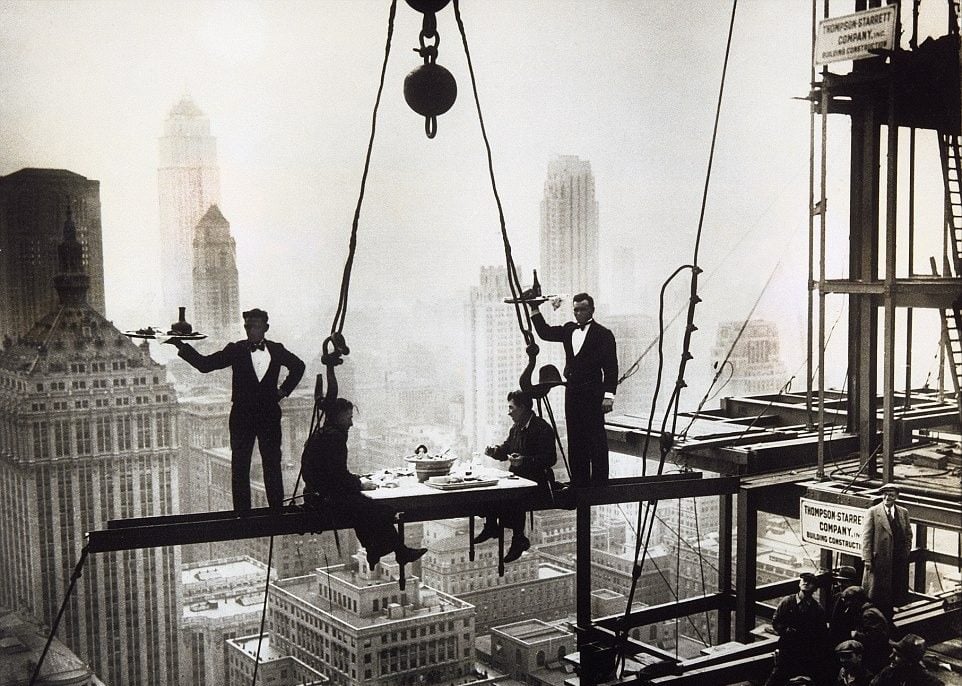Tragic Story Behind Photo Of A Young Worker Dancing On The Steel
In a haunting photograph from 1925, a young construction worker is seen walking a thin plank between two steel girders, blindfolded and high above the bustling streets of New York City.
This isn’t a scene from a movie or a circus act—this was the reality of the men who built America’s early skyscrapers. They were known as “sky boys,” and every step they took on those narrow beams was a gamble with death.
This image captures the fearless spirit of those workers, but it also tells a heartbreaking story of the extreme risks they faced, often with little regard for their own lives.
The making of the photo

The image Taken on November 20, 1925, shows a worker, blindfolded and balancing precariously on a steel girder more than 20 stories above the ground.
Old-timers called this “dancing on the steel”—a dangerous practice where workers would walk along steel beams without any fall protection.

For these workers, the girders were both their workplace and their playground. Some would challenge each other to feats of balance and agility, even as the ground yawned open below them.
The blindfold in this particular image was more than just a prop—it symbolized the casual recklessness with which these men approached their jobs.

But while the photograph might evoke a sense of awe, it’s crucial to remember the tragic reality: many men lost their lives “dancing on the steel.”
The historical context: A race to the sky

In the early 20th century, America experienced an unprecedented building boom. Cities like New York and Chicago were in fierce competition to grow taller and faster.
The era’s industrial barons, men like John D. Rockefeller and Andrew Carnegie, raced to erect the most iconic and imposing skyscrapers, changing the face of urban America. But this progress came at a heavy human cost.

It was commonly said that for every $1 million spent on a skyscraper, one man would die. Workers navigated precarious steel beams without the protective gear that’s standard today.
There were no hard hats, no ropes, and certainly no fall protection systems. The men were often referred to as “sky boys” or “cowboys of the skies” because of their fearless attitudes and agility in working at dizzying heights.

Photographs from this era show workers lounging on beams, climbing wrecking balls, and even enjoying lunch high above the ground. These men were constantly one misstep away from death.
One of the most famous images from this period is Charles C. Ebbets’ 1932 photograph, Lunch atop a Skyscraper, which shows 11 workers casually eating lunch on a steel beam 840 feet above the ground.
The risks and realities of sky boys

Thousands of workers lost their lives during the construction of America’s great skyscrapers. For every stunning photo of a man walking the steel, countless others fell to their deaths, unnoticed and unremembered.
The risks these workers faced weren’t just limited to the early 20th century. Even today, construction remains one of the most dangerous industries.

A tragic reminder of this occurred on July 25, 2014, when a 22-year-old apprentice ironworker in Kansas City fell more than 30 feet to his death. He was standing on a 9-inch-wide steel girder without any fall protection.
The company he worked for, Fastrack Erectors Inc., was later cited by OSHA (Occupational Safety and Health Administration) for seven willful and three serious safety violations.

Even though safety equipment and rules have improved over the years, the company did not provide the protection that could have saved the young worker’s life.

“This young man had his whole life ahead of him. His dreams of marriage, children, and exploring the great outdoors were cut short because his employer failed to provide fall protection,” said Marcia Drumm, OSHA’s regional administrator.
“This tragedy illustrates how quickly a worker can die when fall protection is not provided, and why it’s so important.”

In fact, in 2013 alone, 699 workers died from falls, slips, or trips, making falls the leading cause of death in the construction industry.

